To view this content, you must be a member of the Rose City Review Patreon
Already a qualifying Patreon member? Refresh to access this content.
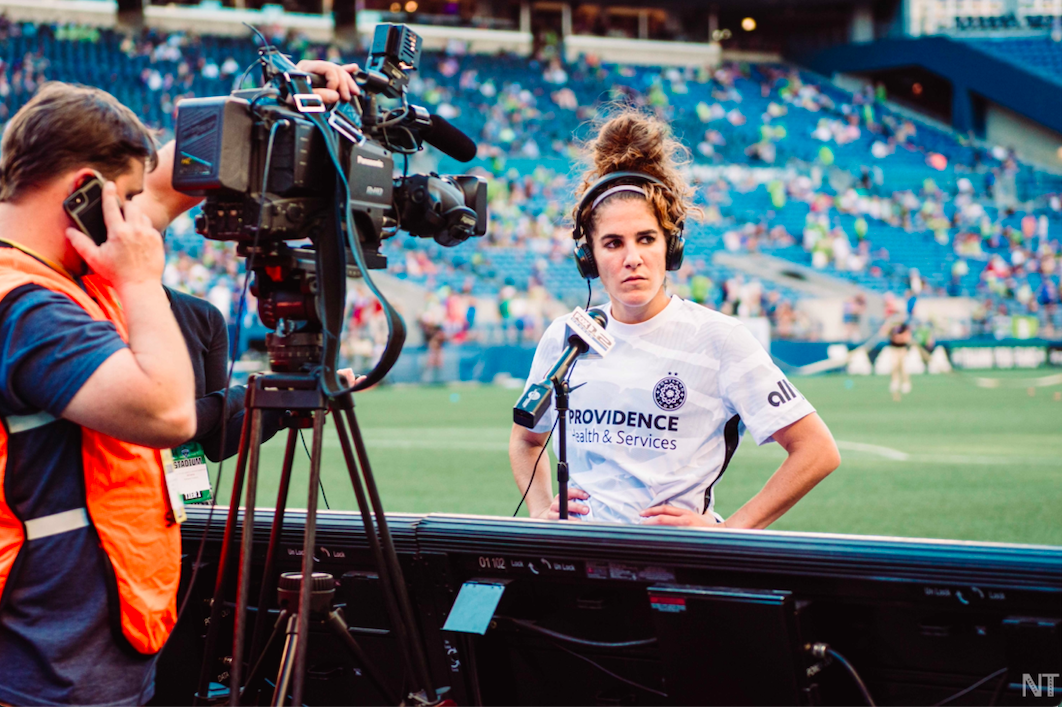
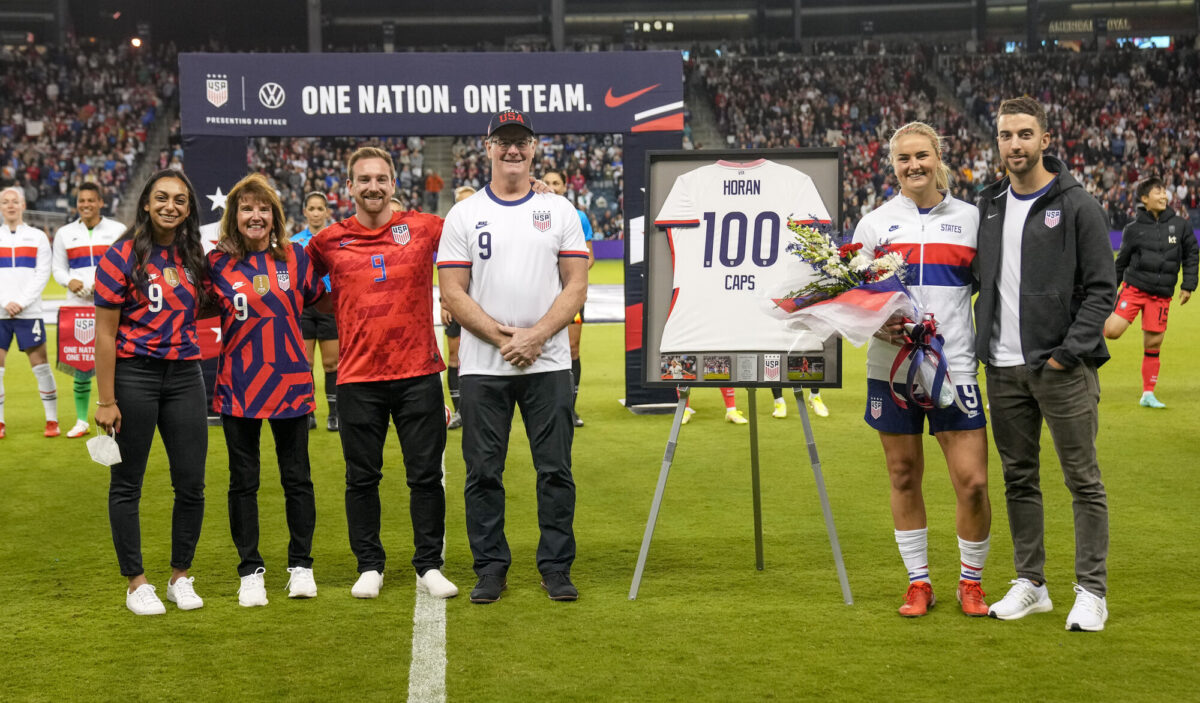
Before forward Lindsey Horan ran onto the field for her 105th cap with the United States women’s national team, she took a second to soak in the moment.
She surveyed the sold-out crowd at Kansas City, Kansas’, Children’s Mercy Park, draped in red, white and blue, not a single empty seat in sight. To her left stood a framed jersey that read 100. On her right was her immediate family, their words drowned out by the applause that reverberated from the south deck to the American Outlaws’ supporters section that temporarily occupied The Cauldron.
Before the game, Horan’s sports psychologist told her to take in every single moment, no matter how big or small. What came of it was an afternoon full of emotion and gratitude.
“I’ve cried about seven times today, ” Horan said.
In the hour leading up to the match, the Coloradan experienced one of the “most special moments” of her career. Forward Carli Lloyd –– about to play in her second-to-last game with the national team –– approached Horan with a jersey. On it, the number 10 sat below the name “HORAN.”
As she absorbed the scene before kickoff, Horan couldn’t help but think about what transpired in the locker room and what it took for her to arrive at that very moment.
“The players on this team are so good and the standard for this team is so high,” Horan said. “To be able to play, work, come into camp and get the opportunity to play for the national team for 100 caps is such an honor.”
Unfortunately for Horan and the USWNT, the on-field result –– a 0-0 draw against the Korea Republic –– wasn’t nearly as memorable. The team failed to win a home game for the first time in 22 attempts and it has been 60 home matches since an opponent held the USWNT scoreless on home soil.
Still, Horan provided some of the United States’ best first-half chances. In the 13th minute, her shot from outside the box deflected off the left post. Six minutes later, the Coloradan got free between defenders at the back post, but couldn’t put enough power on the cross from Kelly O’Hara to beat Korea keeper Younggeul Yoon.
“In the two years I’ve been in this job, I can’t remember that [Horan] has had a bad game or even an average one,” coach Vlatko Andonovski said. “She’s always been above average or super good. Tonight she controlled the tempo of the team, controlled the tempo of the game and had a great mindset.”
All three Thorns played heavy minutes in the USWNT’s draw Wednesday night. Horan and defender Becky Sauerbrunn both started while forward Sophia Smith subbed in in at halftime. Seven players who currently play for the Thorns or have played for the club in the past made Andonovski’s game day roster against South Korea. Some other familiar names? Tobin Heath, Emily Sonnett, Adrianna “AD” Franch and Alex Morgan.
Franch started in goal and kept a clean sheet in her first “home” game with the United States. A native of Salina, Kansas, “AD” recorded her only save in the 35th minutes to help her team secure the clean sheet.
Smith, making just her ninth appearance with the national team, entered the game right after halftime and made an immediate impact. While she didn’t find the back of the net, Smith’s runs into space resulted in dangerous attacking opportunities. When she couldn’t get in behind Korea’s defense, Smith was more than comfortable dribbling past defenders on her own, leaving them in her wake.
“Tonight was one of the first times I’ve felt like [Smith] was at her most confident,” Horan said. “That was really cool for me to see. She was driving at players, pressing, attacking. She can be so special. I’m so proud of her and I think she’s going to be a bright light on this team.”
On Wednesday night, Smith showed why she’s been a constant presence in the USWNT’s camps since the Olympics. After the game, she received a ringing endorsement from Andonovski.
“Ever since she came in there was always something happening,” Andonovski said. “Unfortunately for her, she was either a step short or she took a little too long of a touch. When all that gets corrected with more minutes and more games, she’s going to take care of that and I think she’s going to be unstoppable.”
Again, the United States’ drew 0-0 on Wednesday. But the night wasn’t just about the final result. It was about Smith finding her rhythm with the national team and Horan coming into her own as both a veteran and the next number ten on the USWNT.
“I’ve worked so hard to get to this moment and be a consistent player for this national team. Now I’m more of a vet and more of an older player. So what’s next? That was my change in mindset tonight.”
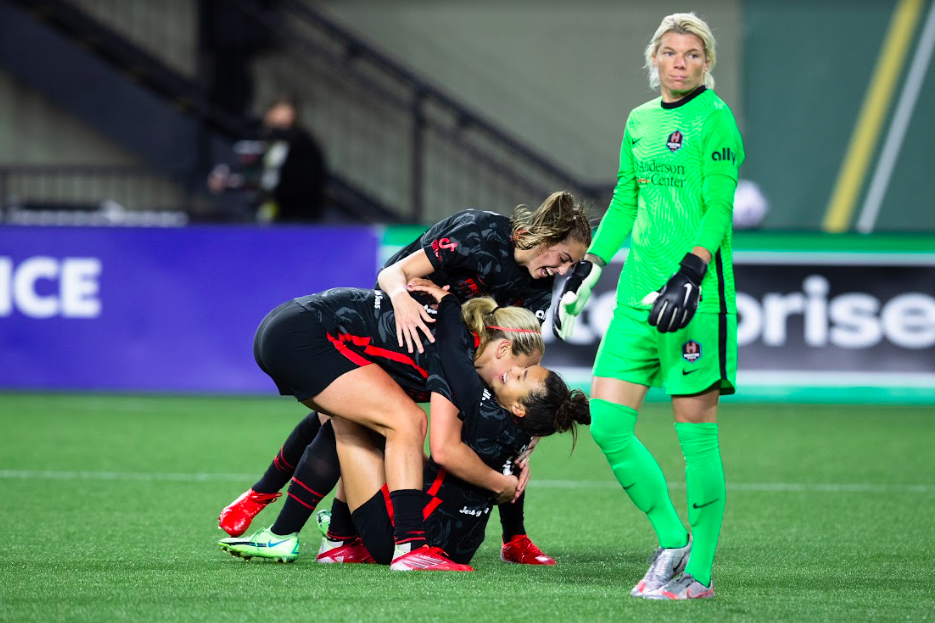
For the Thorns, the 2021 season has been all about building a strong mentality and culture. Through interviews and post-game pressers, Thorns players and coaches have spoken about the importance of their culture shift to their success this season. Back in August, Christine Sinclair said that “[the Thorns] want to put [themselves] in the best position to win, and not by chance,” which has been the byproduct of a team that has fun together—and fights and gives everything for each other.
Since Sinc spoke in August, a reckoning has occurred in the league, with its shockwaves landing firmly in the Thorns’ locker room. In a turnaround from the recent four-game winless streak that’s had people doubting the team’s chances of winning the Shield—something they were favored to do for the majority of the season—the team managed to pull out a win against Houston, looking the best they had against the Dash all year.
The season isn’t over yet, with one last home game against the Courage to go, but I think last night’s win against Houston to claim the shield was a culmination of an entire season’s worth of work both on and off the field. So, in honor of that, here are some things that went really well for the Thorns.
Historically, the Thorns have struggled to break down the Dash’s back line. In the Thorns’ 1–0 win in July, they recorded 14 shots, dramatically lower than usual. Just a few weeks ago in October, the Thorns lost 2–3, putting only nine of 26 shots on target. Forwards Sophia Smith and Morgan Weaver (among others) like to sit high, ready to either get the ball at their feet or receive a long ball over the top, and over the course of the season, the Thorns have struggled to score when they weren’t able to press high and sit along the back line. But last night, Smith and Weaver were able to find all sorts of space between the Dash’s defense, and exploited it well, combining for six shots.
One moment that exemplified the ever-strengthening Thorns mentality was a shot by Sophia Smith in the first half. She was played a ball in from Meghan Klingenberg and after taking one touch to settle it, sent it rocketing towards the goal. She missed, but the important element of the shot was Smith having the confidence to take it early. So many times over the course of the season we have watched Smith dribble towards the goal, only to end up passing it straight to the keeper, and it’s much better for her to test the keeper with a harder, earlier shot than not.
The Thorns have clearly found their ideal starting midfield with Sinclair, Rocky Rodríguez, Angela Salem, and Lindsey Horan (it’s wild that they still have Dunn on the bench to bring on). The passing chart below shows how important it is that the midfield keep their shape in order to dictate play throughout the center of the field. The heavier lines extending from Rocky and Horan’s bubbles indicate the volume of passes that each player gave and received, showing how they maintained possession, continuously feeding balls forward toward the pressing forwards.
Mark Parsons said post-game, “we knew we needed to control everything we can to put it in our favor,” which manifested in the form of the midfield being first to what felt like every ball. They dominated the center of the pitch, intercepting Houston passes and serving as the catalyst for counterattacks, many of which nearly paid off.
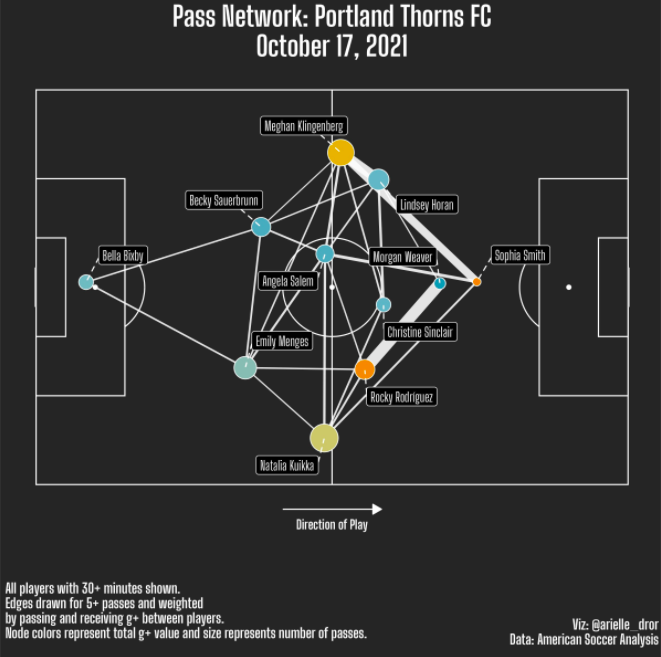
When looking back at the season holistically, the Thorns struggled to reintegrate their international players after the Olympic break, largely due to the bulk of them being in the midfield. Finally having a consistent lineup over the past few months has let the Thorns implement the tactics they have been working on, allowing them to improve each game.
Bella Bixby and the Thorns defense earned their 12th clean sheet of the season, and Bixby’s eighth. While a lot of the glory goes to the forwards and midfield for scoring, the defense has been quietly and consistently dictating games all season. Outside backs Kling and Natalia Kuikka had the most touches out of both teams on Sunday, and center backs Becky Sauerbrunn and Emily Menges contributed to the 48 duels won.
A quote from Bixby sums up the defense’s mentality quite nicely: “despite having big outcome-based goals, we have been extremely process-based, and [are] really just taking it one game at a time.” Bixby, who became the Thorns’ starting keeper after AD Franch went to Kansas City, has excelled at the position. She exudes confidence when directing her back line and stays focused until the final minutes, which yesterday was when the majority of the Dash’s crosses and shots came in. Plus, watching her palm the ball on saves is just epic.
With one more regular-season game to go before postseason, the Thorns are in a good place to continue growing and proving that their elite mentality is what sets them apart.
As Horan said after the game, the Thorns set out to win everything this season—and now the elusive quadruple is within reach.
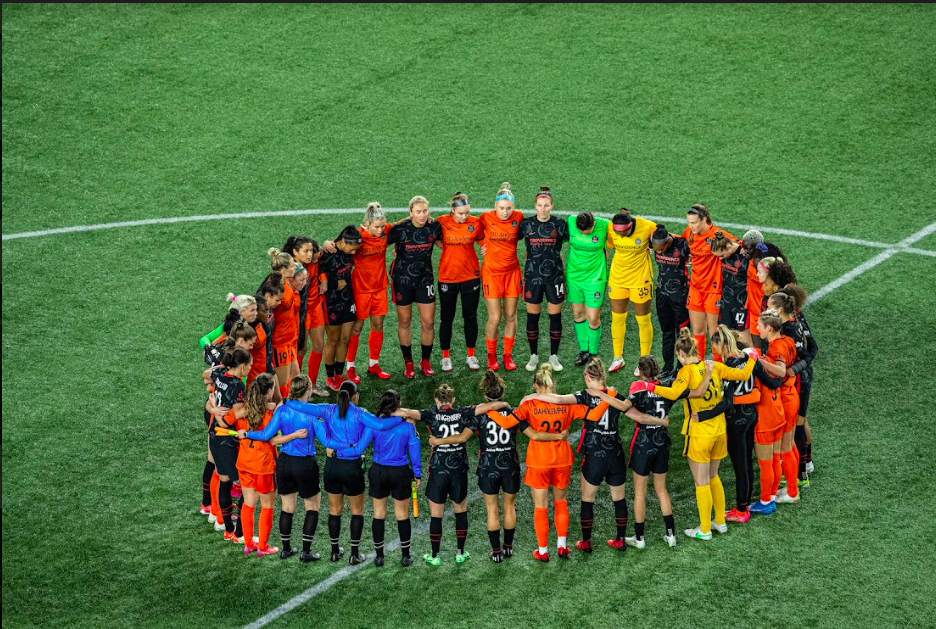
The Thorns suffered an utterly disappointing scoreless tie against bottom-of-the-table Kansas City on Sunday afternoon. While the game could have been momentous for several reasons, including Meghan Klingenberg reaching 10,000 career NWSL minutes, and marking the first time that the Thorns played against AD Franch (who made several great saves), this game is one that is going to be quickly forgotten.
In the 85th minute, it looked like the Thorns would eke out a win when Morgan Weaver was awarded a penalty and Christine Sinclair stepped up to the spot to take it. It unceremoniously went off the lower left post, even after AD dived to the left, keeping the score at 0–0.
In the early second half, Kristen Hamilton scored a goal that was called back due to a foul on Becky Sauerbrunn, and it seemed that maybe this would be the spark of intensity that the Thorns so desperately needed. But again, nothing came of it. The Thorns remained flat and lifeless, looking as though they had little desire to play this game.
Despite being close to soccer-specific Children’s Mercy Park, Kansas City’s home games take place on a baseball field with an extremely narrow and poorly sod soccer field crammed into it (the team has announced it will move to Children’s Mercy Park next year, but the fact they ever played on this field sends a message). The Thorns, who normally thrive off a high press and the ability to get wide, were unable to create space between themselves, causing passes and crosses and shots to all go out of bounds to no one. Mark Parsons noted after the game that “the team wasn’t able to play the type of soccer that they wanted to play.”
That field—and a litany of other factors—made the game hard to watch. It wasn’t just that the team wasn’t playing as well or as organically as they normally do, but that everything going on in the background made it impossible to focus.
In the four days since the Thorns’ last game and the partial dismissal of Gavin Wilkinson (from only the Thorns side of his job), there has been no time to process the sheer amount of trauma that has occurred. Just the day before, broadcasters at the Pride-Gotham game zoomed in on Orlando backup keeper Brittany Wilson and repeatedly misidentified her as Mana Shim. With the endless onslaught of harmful mistakes and disinterest from the league, it’s hard to compartmentalize what is going on. I can’t imagine what it’s like for the players, for whom soccer isn’t a fun distraction, but a job.
Watching the game on Paramount Plus on my laptop felt like a fever dream. I couldn’t conceptualize how 1,600 miles away these people were being asked to play soccer as if there wasn’t a reckoning happening within the league. The quality of the broadcast, which sounded ripped from FIFA 2010, complete with LMFAO playing at each corner kick, felt like a slap in the face. Not only can the league not listen to players, but they seem completely unwilling to invest in them, either.
The camera’s low vantage point and tight angle made it so that no more than half the players could be seen at any given moment. Players moved in and out of frame in dreamlike apparitions. The Thorns’ white jerseys looked as though they were outlined in black crayon, making them look cartoonish and animated. At one point, Larroquette did a bicycle kick at midfield just to advance the ball seven yards. I instantly did a double take to check that I wasn’t mashing buttons on a Playstation controller.
All in all, it felt like a rerun of a game from the inaugural 2013 season, one whose final score I already knew. It was hard to get invested and feel as though anything was at stake, when in reality, there’s a lot on the line. The Thorns only have four more games this season, and have choked on their lead, leaving only one point between them and Reign in the race for the shield.
But that brings me back to my original point. It was impossible to focus on the game because there is so much more at stake than a soccer game or title right now. Everyone on that pitch carried an incredible weight on their shoulders for 90 minutes. Once they step off the field, the weight remains squarely on them, getting straight onto phone calls and trying to fight for the league. There really is no escape for these players as they are constantly told they aren’t worthy, whether they’re being made to play on a horrible pitch or being asked in a postgame presser to recount their involvement in the initial 2015 investigations within the club.
As the season winds to a close and the games pick up in intensity and importance for the postseason bracket, I find myself disconnecting with the game more and more. The Thorns could lose every game from here on out, but I would still support them just as much as if they won all of those games 5–0. The players’ mental and physical health is the most important, and if they choose to protest at Wednesday’s game, I will fully support and understand. If I as a fan can’t focus on the game, how can the players?
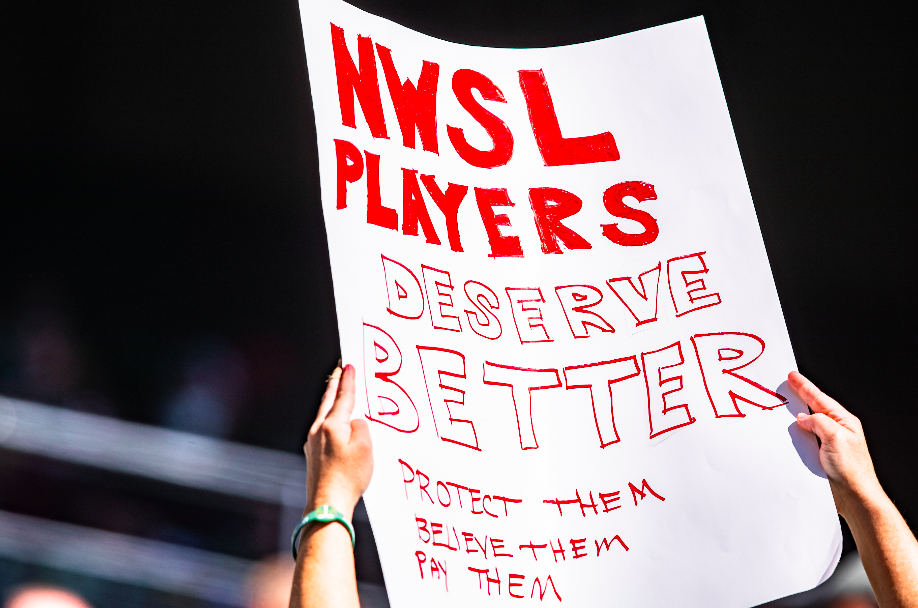
On Thursday, The Athletic reported that former Thorns head coach Paul Riley sexually abused and coerced multiple players during his tenures with multiple professional women’s soccer teams—including his time in Portland. Sinead Farrelly and Mana Shim brought these reports to the attention of front offices, commissioners, and other league officials, but by no means are they the only survivors of Riley’s abuse.
Although Riley has been fired, NWSL commissioner Lisa Baird and general counsel Lisa Levine have resigned, and SafeSport—a questionable place to turn—is now investigating the allegations against Riley, we, at the Rose City Review, find lack of transparency and action until this point to be unacceptable.
It’s not enough for coaches and managers to apologize for hiring known abusers, as OL Reign owner Bill Predmore apologized for hiring former head coach Farid Benstiti in a press conference on Friday. “Getting it wrong” is not an excuse when there are known, credible accusations against a man. The systems of complacency within the NWSL run deep. We’ve seen them play out time and time again this year, with the terminations of Riley, Benstiti, and Richie Burke. And we’ve seen that same lack of transparency around the firing of Christy Holly, Alyse LaHue, and Tom Torres.
And it’s not enough for Riley to resign when the people who covered up his abuse remain in power. According to The Athletic’s report, Thorns owner Merritt Paulson and general manager Gavin Wilkinson released Riley from the club after investigating Shim’s allegations against him, but neither the club nor the league publicly acknowledged those accusations or that there had been an investigation. Despite knowing that Riley was a sexual abuser, Paulson, Wilkinson, and the NWSL let the league hire Riley for another job, placing him in yet another position of power.
We believe the Thorns’s statement on the report does not adequately address the harm the club has caused—nor does it outline a plan to keep players safe in the future. Merritt Paulson’s open letter, while outlining positive steps forward for the club, does little to acknowledge the complicit behavior of the Thorns’ front office. The “North Star” that he references as what is best for the players and techinical will need to involve the removal of Gavin Wilkinson to create a more safe and open environment.
We support Mana Shim, Sinead Farelly, Kaiya McCollough, and everyone else who has come forward about abuse—publicly or privately.
We stand with the NWSL Players Association and their three demands. We commend the NWSLPA for the work they’re doing to push better league conditions and create avenues through which players can report abuse, but that work should have never fallen on them.
The steps outlined in Paulson’s letter are positive, and we will be following up to ensure that he follows through on them. But we believe that the club’s current plan is not enough. We feel it is unacceptable that Gavin Wilkinson remains the club GM, given his role in covering up Riley’s abuse. We are calling for his removal from the Thorns and Timbers organization.
You can donate to the NWSLPA via PayPal.
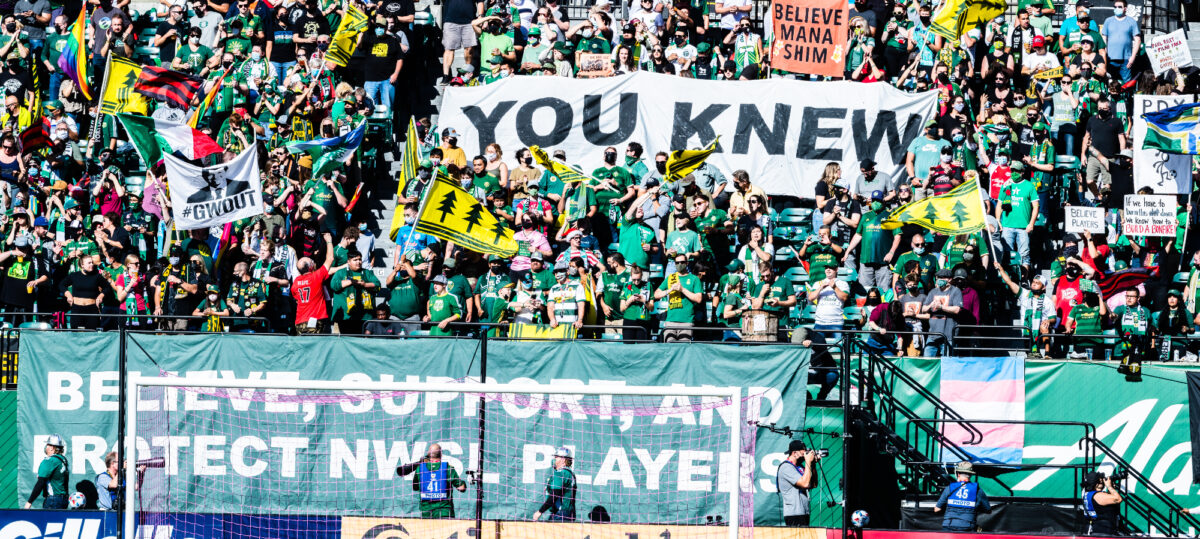
It was, by many of the usual metrics, a lovely Sunday afternoon at Providence Park. The sun was shining, the air was crisp, and the Portland Timbers won their seventh game in eight attempts, continuing an improbable run up the Western Conference table that has them positioned to contend as the weather finally begins to turn and the MLS season enters its final stage.
But the result, a 1–0 Timbers victory on the strength of a late headed goal from the Polish marksman Jarosław Niezgoda, felt like little more than a sideshow.
This Timbers victory should have been the second game of the weekend played at Providence Park. The Portland Thorns were supposed to take the field first, on Saturday, for a derby match against their northern rival, OL Reign.
That match did not happen. In its place, after all games across the NWSL were suspended following the horrifying revelations reported by The Athletic last week regarding the conduct of former Thorns manager Paul Riley, Thorns supporters rallied outside the stadium in support of the players Riley abused and those who remain within an American soccer league that has at every turn disregarded their safety.
They also called for the firing of Timbers and Thorns general manager Gavin Wilkinson, who has emerged again as a lightning rod for anger.
Timbers fans last called en masse for Wilkinson’s firing in the autumn of 2012, when the club was suffering through a miserable season on the field. They were wrong then. The Timbers won the Western Conference the next season and an MLS Cup two years later, and Wilkinson’s prowess as a soccer executive has proven beyond any significant doubt many times since.
They’re not wrong now. This time, the frustration is not that Wilkinson can’t pick soccer players. It is that he, along with Timbers and Thorns owner Merritt Paulson and the club’s president of business Mike Golub, failed to ensure that Riley’s career ended after they were made aware of the allegations of his predatory, coercive, absolutely despicable behavior towards their players.
The club investigated Riley following the 2015 season and, with his contract expiring, let him walk. We don’t know exactly what that investigation turned up, and we don’t know exactly how seriously the club endeavored to communicate to the NWSL and Riley’s future employers that he was an active danger to their players too.
What it looks like, lacking that information, and knowing the connections between the Wilkinson and one of the men responsible for hiring Riley to his next job, is that the Thorns, like the Catholic Church, simply moved an ill-behaved coach on to his next parish, consequences be damned.
Sinead Farrelly. Mana Shim. How many others there are—both among those who spoke anonymously to The Athletic and those who weren’t reached or chose not to be interviewed—we don’t yet and will probably never know.
Timbers players Saturday released a statement expressing their support for NWSL players, while Giovani Savarese and other members of the Timbers coaching staff wore teal ribbons in a show of solidarity.
Savarese and his team entered Sunday in a difficult position. Around them in the stadium, and particularly in a vociferous North End, the supporters called—colorfully, loudly, and repeatedly—for their boss to be fired.
The Timbers Army, singing and chanting to the beat of a drum branded with the logo of the Rose City Riveters, made their position known from pregame to the final whistle. Banners hung or hoisted in the North End included “Believe, Support, and Protect NWSL Players,” “Protect the Players, Cut the Rot Out,” and, most memorably, a simple, “You Knew,” along with plenty of two-sticks aimed specifically at Wilkinson.
All the team on the field could do was focus on the task at hand, no matter how trivial it felt taking place in the middle of one of the biggest storms in franchise history.
Knowing a win would cement their status as in the West’s top four with Real Salt Lake’s loss on Saturday, the Timbers faced a Miami side in desperate need of points to keep their distant playoff hopes alive.
Starting without Sebastian Blanco, whose return to fitness was so critical in their revival this fall, and with Diego Valeri suspended for yellow card accumulation, the Timbers lacked a measure of attacking inventiveness in the first half. But Miami was rarely more than ponderous going forward themselves, with the Timbers comfortably defending deep and looking to break with pace.
When Blanco was introduced with a quarter of an hour to go in the second half and no score, the Timbers quickly began to rack up chances. It was thanks only to some excellent emergency defending from Miami’s three center backs, led by Leandro Gonzalez Pirez that the game remained level for as long as it did, and thanks to some very soft defending in the middle of that box that Niezgoda was allowed to freely position himself in the path of a Blanco corner seven minutes from time and nod in the opener.
Miami thought they had equalized just moments later when substitute Julian Carranza headed a cross past Clark, but the goal was ruled out for a push on Dario Zuparic. Miami manager Phil Neville said after the game that his team was “robbed,” and perhaps in a narrow sense, he was right. The whistle on Carranza was soft, one of a number of marginal calls that so often decide close, pedestrian late-season games.
But in a broader sense, his team did not take advantage of the opportunity presented to them in Blanco’s reduced fitness and Valeri’s suspension. They lost the expected goals battle by nearly two and only forced Steve Clark into a pair of notable saves, one on an uninspired Gonzalo Higuain, the other on Brek Shea.
Miami had one more great chance after Carranza’s equalizer was ruled out, deep into stoppage time, but Gonzalez Pirez, outstanding on the other end of the field, sent his open look well wide. That was it. The Timbers are now seven points clear of fifth, on a glide path to hosting a playoff game.
Afterwards, Savarese and Clark were asked about the NWSL. For many of the supporters, the afternoon ended with that subject—and the club’s response to it—foremost in mind. The Timbers Army and the Rose City Riveters are extraordinary in the American sporting landscape for the outspokenness and seriousness with which they take their sociopolitical commitments.
They also, in recent history, have been extraordinary for their effectiveness. The supporters, with the help of others across the MLS, namely in Seattle, stared down the league and won its fight to fly the Iron Front in 2019. The coming fight to hold the organization accountable for its role in perpetuating Riley’s career will, in many ways, be a much bigger challenge.
Paulson’s most enduring trait in a decade-plus as a major league owner, right alongside his passion and inability to stay off Twitter, has been his loyalty to and faith in Wilkinson—a loyalty that has been richly rewarded in on-the-field success.
This scandal is not not going away any time soon. U.S. Soccer and FIFA have opened investigations. The NWSL remains in turmoil, with the Thorns scheduled to play the Houston Dash at home on Wednesday night. Their current manager, Mark Parsons, who is vacating the role in a matter of weeks, has not faced the media since the story broke.
The level of protest at this, a Timbers game, not a Thorns game, made that plain It is as yet unclear what is coming next for Riley and everyone who passed the buck and did the bare minimum instead of stopping him cold. But it is obvious, if there was ever a doubt, that Portland fans are going to keep close score.
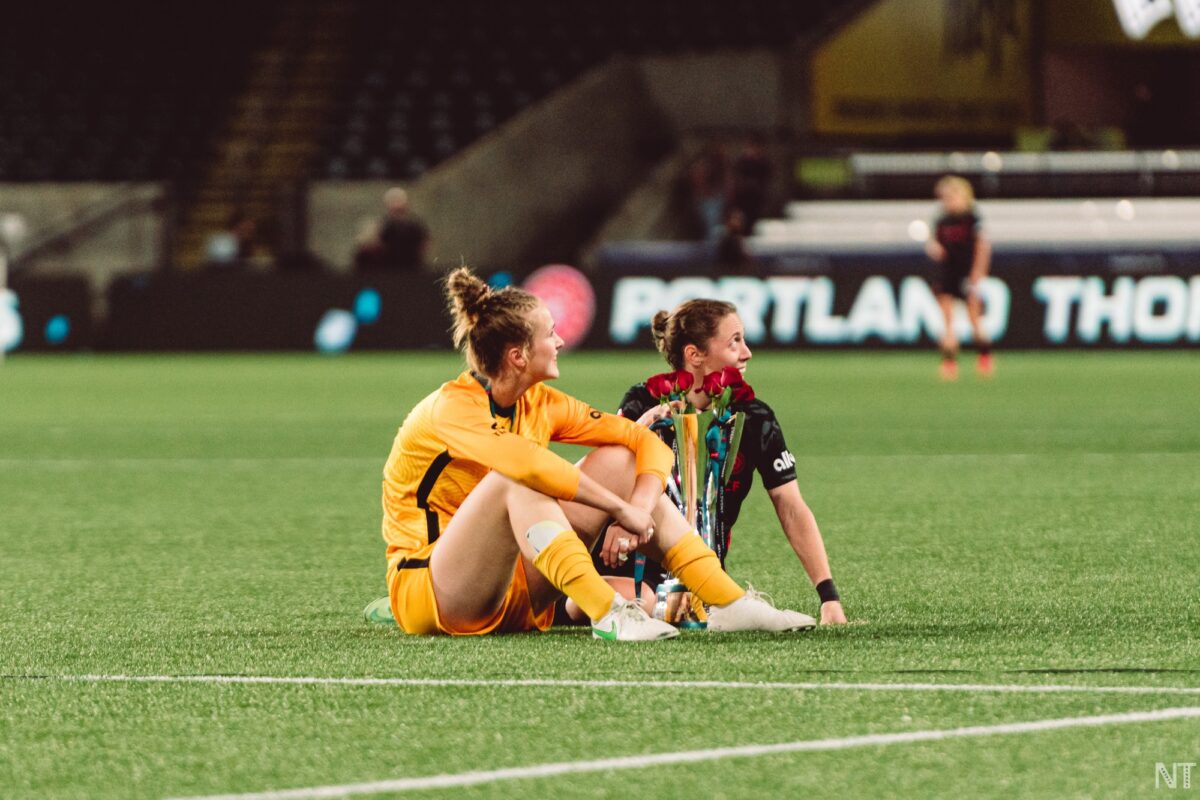
Before enlightenment: chop wood, carry water. After enlightenment: chop wood, carry water.
In 2015, Meghan Klingenberg was a standout with the US national team. At the World Cup that year, she started every game for a back line that conceded just three goals—including a Julie Ertz own goal—all tournament. She had a moment in the spotlight with a dramatic goal-line save against Sweden to rescue a clean sheet. There was no reason to suspect the 26-year-old would be on the bubble just over a year later.
But that’s exactly what happened. At the beginning of 2018, Kling was dropped for good, with little noise and less ceremony. That’s what happens when you get cut. There’s no party. One day you’re there, the next you’re not.
“It was really hard,” she remembers. “I had a lot of bitterness about it.”
The story of Kling’s break from the national team wasn’t fully told at the time. In 2016, after the Americans’ ill-fated Olympics run, she suffered a back injury, which the USWNT staff identified as a pulled muscle. In fact, it was a more severe injury that required surgery, and the misdiagnosis set her recovery timeline back significantly.
After recovering from surgery, Kling set about getting back to her 2015 form. She made a strong case for herself in the 2017 Thorns season, establishing herself as a key piece in the offense—a role she still plays today. She notched seven assists that season, the third-most in the league after Kristie Mewis and Nahomi Kawasumi; she was the only defender to record more than three. At the end of that season, the Thorns won the championship.
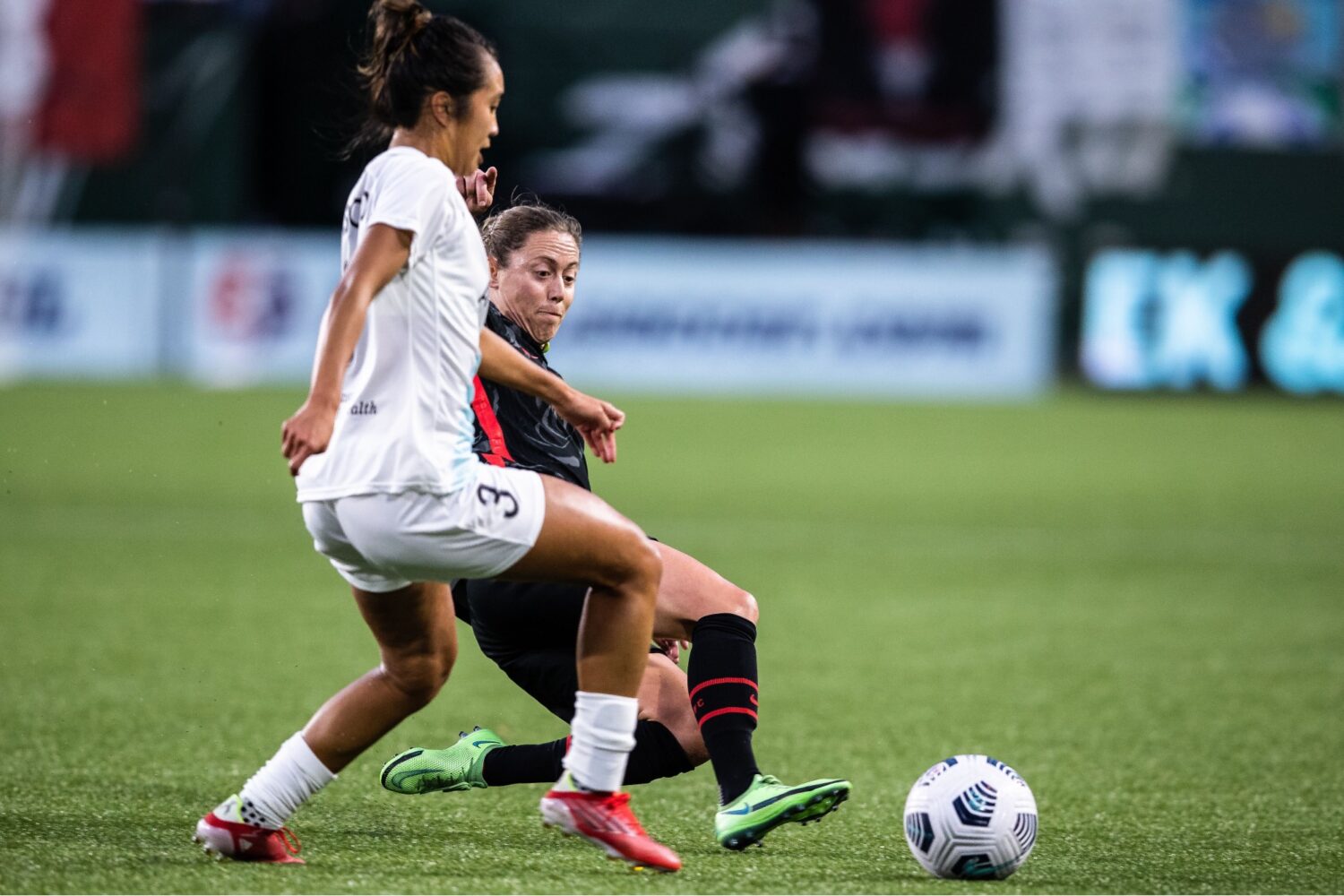
But she never really worked her way back into the national team conversation. From an outsider’s perspective, what’s especially baffling—insulting, frankly—is the lengths the team went to in their search for outside backs leading up to the 2019 World Cup.
Jill Ellis’s staff tried converting Sofia Huerta, a failed experiment that nonetheless prompted Huerta to move from the Red Stars to the Dash; they gave famous homophobe Jaelene Daniels (née Hinkle) a second chance after she’d refused to play in a Pride Month jersey. For their part, the stans—many of them, anyway—wanted Ali Krieger back in the picture and howled for blood every time she was left out of a lineup. We all know how the search ended: with Crystal Dunn, one of the most dangerous attacking players in the world, becoming a locked-in starter at left back.
All that happened because the foregone conclusion, before she’d even had the chance to recover fully, was that Kling’s time was over.
That was a blow. “It felt unfair to not be given a chance with the national team, knowing that I had this injury that they had misdiagnosed for a long time,” she remembers. It’s one thing to get fired because you messed up; it’s another to get punished for someone else’s mistake.
“I could not find joy in the game. I was just playing to get back to where I was.”
Zen master Dongshan Liangjie of Mount Dong said to the assembly, “Experience going beyond Buddha and say a word.”
A monastic asked him, “What is saying a word?”
Dongshan said, “When you say a word, you don’t hear it.”
The monastic said, “Do you hear it?”
Dongshan said, “When I am not speaking, I hear it.”
But that was then. Times have changed.
“I guess the only way that I can put it is that the past doesn’t exist, and the future isn’t real.”
I’m talking to Kling in the stands at Providence Park on a warm day in August. We both have masks on; hers is gray plaid with a Pittsburgh Steelers logo. 2015 was a lifetime ago. Longer—a different plane of existence. The whole Trump administration sits between now and then.
“All we have right now,” she continues, “is this moment right here in front of us. And we get to choose what we want to do with it. If we want to be distracted and not be here, present, we can choose to do that… I think when we choose presence, a lot of other things happen because of that.”
For Kling, this wasn’t an easy lesson to learn. It’s not a mindset that comes easily to professional athletes, for whom performance matters, and hypercompetitiveness is a job requirement. But excellence is paradoxical: the more you fixate on results—on the free kick you whiffed or the bad day you had in training—the less you focus on the process of getting the results. A focus on winning turns into a fear of losing. That fear plagued her, even as she remained a key player for the Thorns through 2018 and 2019.
“I was one of the most outcome-driven athletes that you could find, before I had this kind of paradigm shift,” she says. “And it just wasn’t working for me anymore. I was having all kinds of anxiety, three quarters of a month. I was having trouble physically breathing, because I was having so much anxiety about how I’m going to play, how I’m going to do, what happened last game, all these different things.”
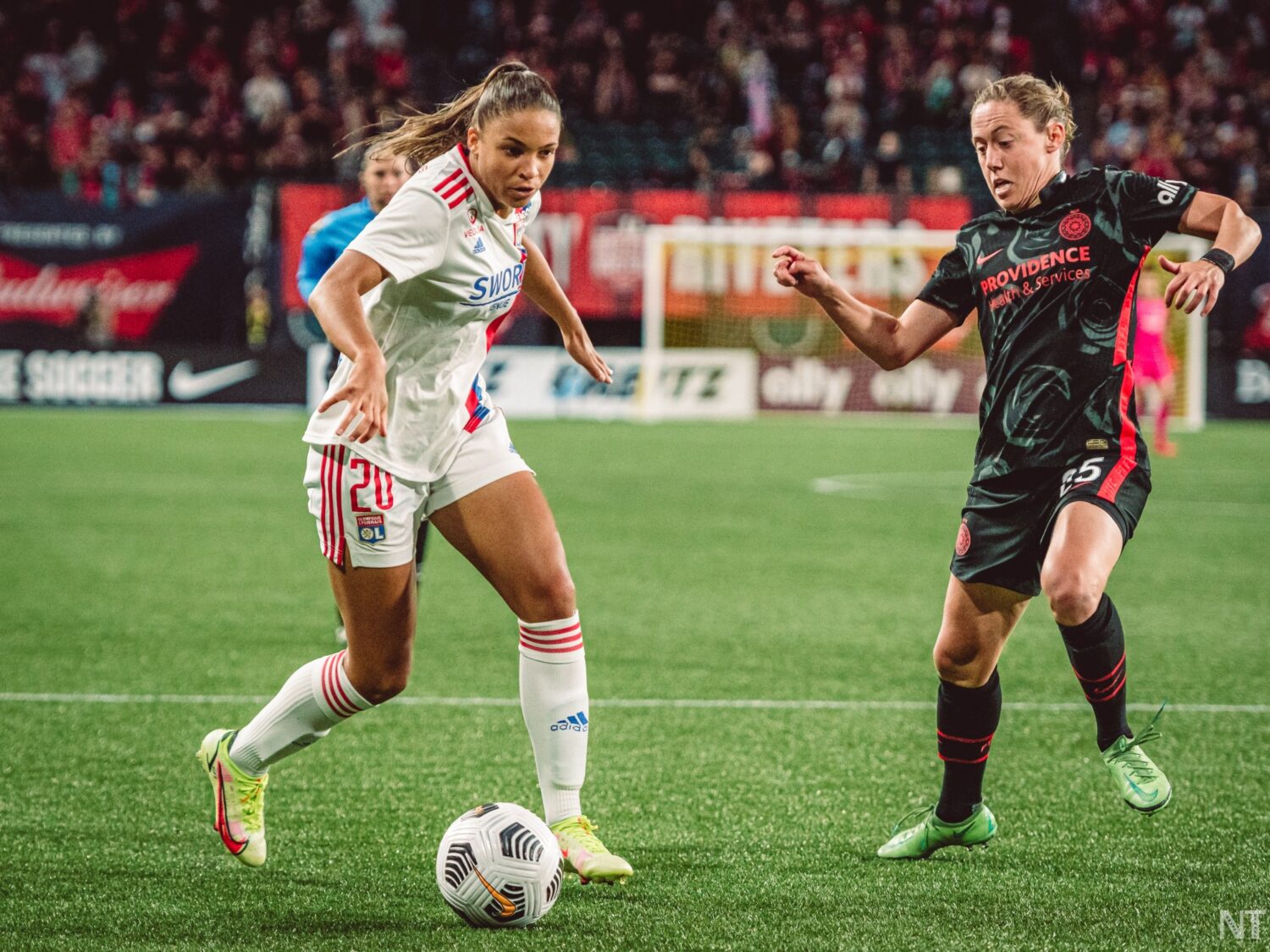
In early 2020, something snapped. “I was just like, so tired,” Kling remembers, “of having anxiety all the time, worrying about the next game. My body would get tight when I’d play, then I’d relax for a few days, and then it would build, build, build. It was like, 10 years of that.”
Through a friend, she got in touch with a performance coach named Jason Goldsmith, whose core philosophy is to teach athletes to focus on the things they can control and let go of the things they can’t. “[Whether] you win or lose, or if you play well, or statistically do well, all of those things, you know, are not something that’s controllable,” Goldsmith says.
Even the best players in the world miss tackles and hoof shots over the bar. As a defender, sometimes you can save the day, and other times you have to go one-on-one against Lynn Williams. “What is controllable,” Goldsmith says, “is, how do you feel when you are playing?”
One tool he uses with athletes is a biofeedback device called a FocusBand, a wearable EEG that connects to a smart phone and allows the user to directly monitor their brain activity. “The benefit of having something like that,” he explains, “that gives you direct feedback, [is that it] allows you to explore different meditation practices in a way that you can see, ‘oh, when I do this, when I focus on this, this is how it’s affecting my brainwave frequency. Or if I do this, this really doesn’t work.’”
In Taoism and Zen Buddhism, one goal of meditation is to enter a state of mushin, or “no-mindedness.” It’s a state of complete engagement in an activity—whether that activity is meditating or kicking a soccer ball—without thought or judgment.
“If you had the device on and you were thinking about how to play,” Goldsmith explains, “you’re no longer playing.”
That state of mind, sometimes called “flow,” is an indispensable tool for athletes, or anyone doing a high-skill task that requires intense concentration. It also has a neural fingerprint that the FocusBand can pick up on. For Kling, Goldsmith sewed the device into a hat, so she could wear it throughout the day. Using the band as part of a daily mindfulness practice, she transformed her outlook.
“Sometimes we go to the grocery store, right,” she explains, “and we’re standing in lines waiting. But what are we waiting for? We’re waiting for the future.” The future, though—as we’ve already discussed—doesn’t exist. At some point, Kling realized, “I don’t need to wait. I can just be.”
That shift helped her reconceptualize the game of soccer. “When I first got [to Portland], it was all about outcomes. How do I make 100% passing, how do I create the most chances? How do I stop the most one-v-ones, all these different things. And I would just data myself to death.”
By shifting her focus away from outcomes, Kling says, “everything slowed down.” Instead of thinking about completing passes or chances, or winning the ball back in specific moments, “I just think about it in terms of space. How do I get my body and this ball into this area? Instead of seeing defenders running at me, or where my players are running, I more see everything at once.”

The excellence paradox works in reverse, too. Not worrying about the numbers has enabled Kling to improve her numbers. So far this season, she has a 78.5% pass completion rate, about 5% more than she had in 2019, a 43.9% long pass completion rate—a 10% improvement—and is attempting about 57 passes per game, compared to 43 in 2019.
“For [Dōgen], each moment of practice encompasses enlightenment, and each moment of enlightenment encompasses practice. In other words, practice and enlightenment—process and goal—are inseparable. The circle of practice is complete even at the beginning. This circle of practice-enlightenment is renewed moment after moment.”
–Kazuaki Tanahashi, Enlightenment Unfolds
Kling’s journey over the last three years parallels that of the Thorns as a team. “[In] ‘16 and ‘17, we were very, very focused on the process,” Mark Parsons says. What he means by “process” is a relentless focus on getting better as a group, according to an abstract vision of the kind of team they want to be, rather than numbers of wins and losses. Train well, work hard, strive for improvement, and the results will follow, the reasoning goes. “‘18, ‘19, I think we got—I got—distracted with the outcome,” he says.
It sounds a little absurd to say there was something wrong with a team’s approach in two seasons when they went to the league championship and the playoff semifinal, respectively, but within the team, something had soured. The Thorns want and expect to be the best, and with their resources, there’s little excuse not to be.
From the outside, nothing seemed particularly amiss during that time. You had to know what to look for: a player reporting late for uncertain reasons, a vague disjointedness and a whiff of frustration in the attack. The team’s culture issues came to a head at the 2019 semifinal at Chicago, when Caitlin Foord, Midge Purce, and Hayley Raso started on the bench. After the 1–0 loss, AD Franch alluded to internal fracture, saying the team needed to “regroup, find our culture, and get back to who we are.”
Some of that was a personnel issue; too many players, regardless of quality, weren’t bought into Parsons’s vision for the team. The club cleaned house over the offseason and brought in the likes of Rocky Rodríguez, Sophia Smith, and Morgan Weaver. At least as important was that the coaching staff took a long look in the mirror and realized they’d strayed from their core values.
Effort is the first of those values. But that’s hardly unique, either when looking to Parsons teams of past years—if I had a nickel for every time I’d recorded him talking about “maximum effort,” I’d have, well, quite a few nickels—or when you think about the whole edifice of team sports, especially in this country.
What’s new for this version of the Thorns is the striking literalness with which they apply their stated values. You don’t have to speak with anyone on the team to know this; you can see it on the field. They want to improve at one specific style of play, so they use the same basic game plan every week, regardless of personnel.
Most teams, including the Portland of two or three years ago, line up different ways in different situations, moving to a back three or employing a different pressing scheme to fill in the gaps when certain players weren’t available. Now there is one plan, with clearly defined roles at every position, which every player on the roster knows like the back of their hand.

The goal is to win. But they see winning as a long-term goal, not an immediate one. Winning this week is one thing. They want to win the league.
“If we live the rollercoaster of winning and losing and tying with the ball going in or the ball not going in,” Parsons says, “we’re just a team that defines ourselves by outcome. But medium- and long-term success isn’t decided by outcome. It’s about improvement.” Control the controllables, and the rest will fall into place.
Parsons and Kling both use the 2020 Challenge Cup as an illustration.
“We went into the COVID Cup in 2020 and came in last in the preliminary stages,” Kling says. “But that’s because we were so beholden to our mission, we were so beholden to the process, that we were not going to change what we were going to do just to get results. I know that really bothered a lot of people, but it didn’t bother us.”
“We all knew we were on a different journey,” Parsons says.
When Buddha was in Grdhrakuta mountain he turned a flower in his fingers and held it before his listeners. Every one was silent. Only Maha-Kashapa smiled at this revelation, although he tried to control the lines of his face.
Buddha said: “I have the eye of the true teaching, the heart of Nirvana, the true aspect of non-form, and the ineffable stride of Dharma. It is not expressed by words, but especially transmitted beyond teaching. This teaching I have given to Maha-Kashapa.
“I had to realize that life wasn’t fair,” Kling says.
Unfairness—along with pain, loss, and regret—are inevitable. What we can change is how we react. In Buddhism, the cause of suffering is not what happens to us, but the way we push back internally against it. You can be bitter forever, or you can learn to let go.
The idea of getting back to where she was—back to her 2015 form, back to the national team—took some time for Kling to let go of. “But,” she says now, “there’s no getting back to where I was, and why would I want to anyway? Why would I want to go back in the past when I could take all of that information and use it now, and be a totally different player, be a player that I want to be?”
Arguably, she’s better now than she was then. She’s having the club season of her career. More important, she’s found joy in the game again. As she said in a press conference during the 2021 Challenge Cup, “I’m literally having a fucking blast right now.”
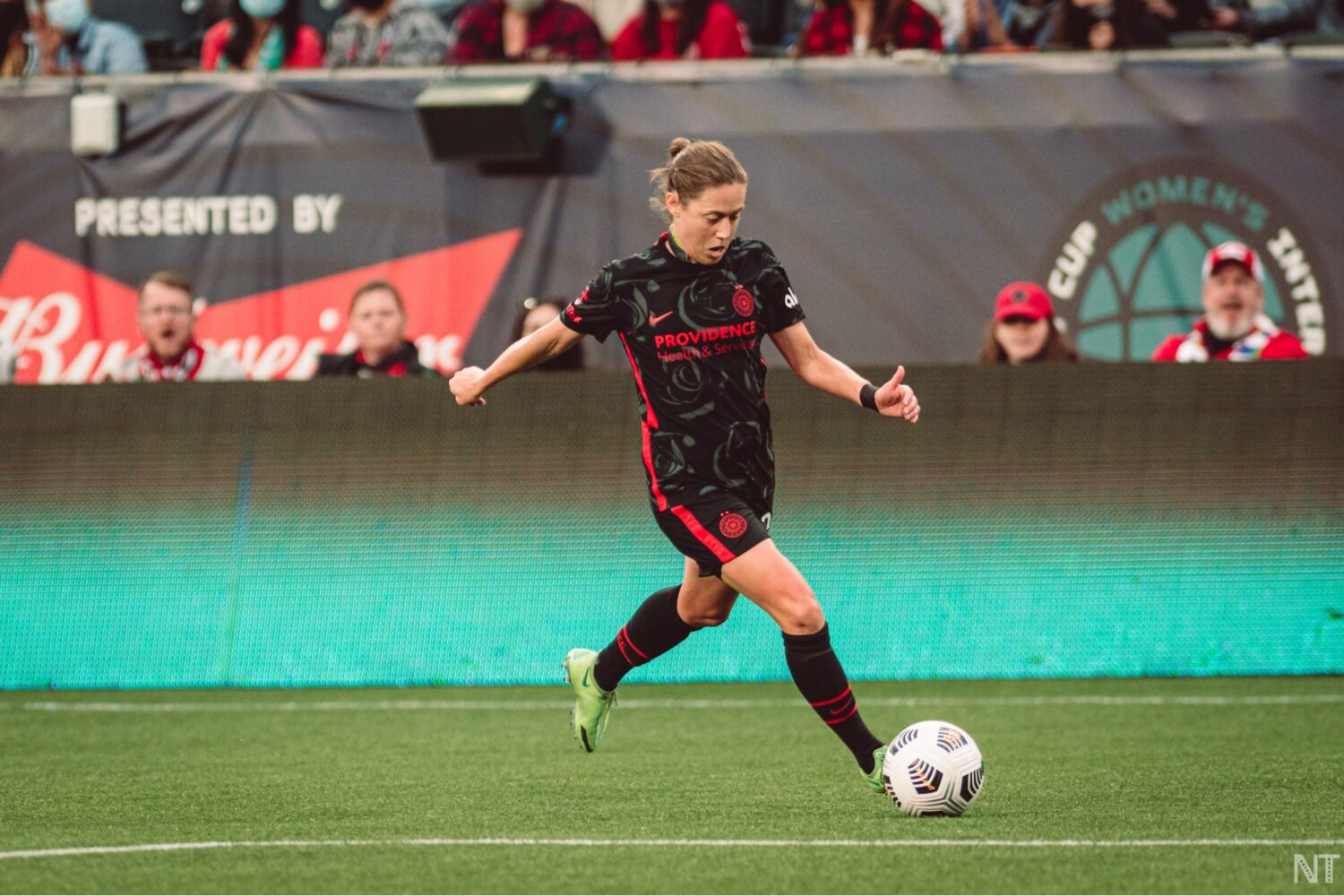
“I’ll tell [friends and family] stories that happened in practice,” she says, “and they’re like, ‘do you ever practice? All I hear about is you laughing, all I hear about is you telling these crazy-ass stories!’ And I’m like, ‘yeah, well, we do that the entire practice. All I do is laugh and play hard, the whole practice.’ I love that, because to me, joy is one of the main drivers of me getting better. When I’m laughing and having fun with my friends, I know that I’m fully tuned in to exactly what we’re doing.”
She sees the pressure, the anxiety, the feelings of inadequacy she long struggled with in other elite athletes. It’s getting more common for athletes, many of them women—Naomi Osaka, Simone Biles, Christen Press—to pull out of competitions for mental and emotional injuries in addition to physical ones.
Those injuries are complex and often rooted in off-field trauma, but to the extent that competition itself exacerbates them, Kling says, “I personally feel like we’ve let these women down. We never taught them that competition should be joyful. We never taught them to be just content with exactly who [they] are.”
“All I want for them is to be able to step up onto the biggest stage of their lives, knowing that they have done everything that they can possibly do to get to that moment, and enjoy it.”

The Thorns recorded their first ever win away against the Courage on Sunday. The game was touted as a “top of the table clash,” and Kelli Hubly said afterward that “rivalry between the Courage and the Thorns might be bigger than that against the Reign” because both teams have won multiple NWSL titles. Despite the 1-0 scoreline and the Thorns’s 2-0 loss in Cary earlier this year, Portland dictated the tempo from the beginning and dominated in shots, possession, and passing.
The Courage didn’t look as threatening as they have previously this season—they were unbeaten in their last seven games—and weren’t able to get many shots off. While this could be attributed to internal issues and player turnover on the team, the Thorns’s midfield have to get credit for effectively pressing and shutting down North Carolina’s box midfield.
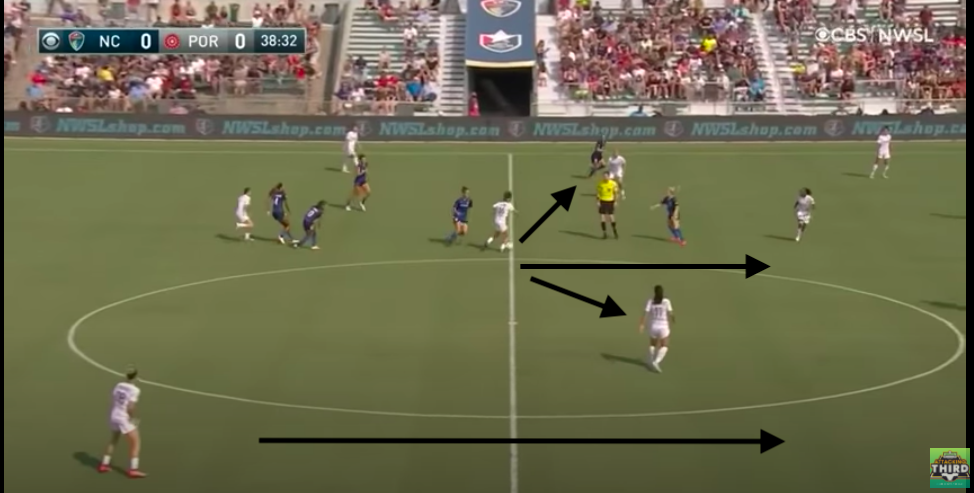
In the above image (Thorns are moving left to right), it’s easy to see how much space the diamond midfield had. Angela Salem has the ball in the center of the pitch, and she has several easy passes to choose between. There are four Courage players within about a 10-yard radius, all of whom are behind the play. She chooses to play it forward to Crystal Dunn, who holds the ball and feeds it through for Sophia Smith to go 1v1 on goal.
Due to the fact that the Thorns can never seem to have all their forwards healthy at the same time, Christine Sinclair has transitioned into playing the No. 9 striker role since she returned from the Olympics. This switch allows Crystal Dunn to slide forward play the No. 10 center attacking mid, where she’s been more successful than she was in the deeper midfield positions in the diamond. Here, she is able to be a playmaker. With 50 touches and 76% passing accuracy, Dunn was an effective link between Sinclair and Smith up top and the midfield. The combination of those lines allowed the Thorns to outshoot the Courage 23-11.
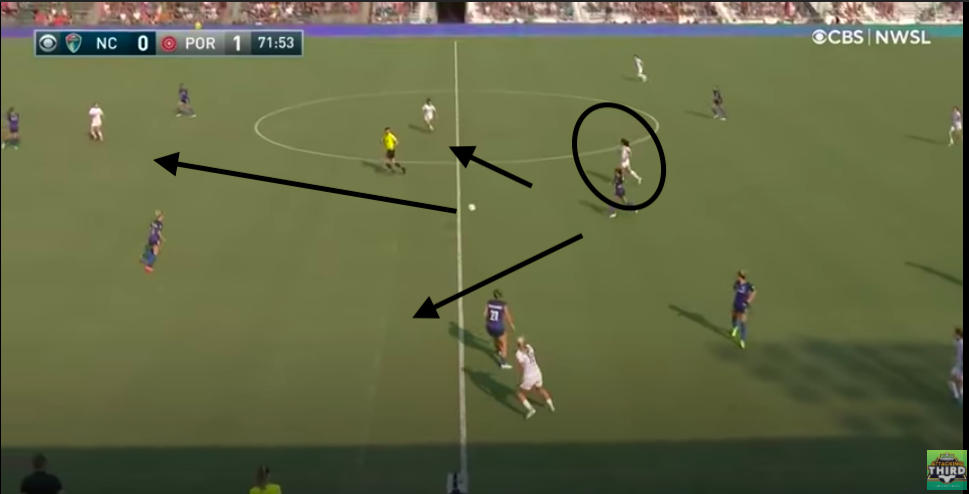
In this image (Thorns are moving right to left), you can see Portland’s midfield holding their wider shape—as they did throughout the game—and consistently beating out the Courage’s. Lindsey Horan (bottom middle) plays the ball centrally, and Rocky Rodríguez is able to easily receive it. Due to the high press and wide shape, Rodríguez has several options to keep the ball moving around North Carolina.
The strength and consistency of the midfield against North Carolina is an example of the “Thorns mentality”—a phrase that players and coach Mark Parsons have repeated throughout the season. After the game, Parsons said they “want to be constantly improving and playing as a team because that will push [the team] towards [their] best.” He shouted out Dunn and Salem as two players who exemplified that mindset. As the last third of the seasons approaches, the Thorns will look to build on the consistency and success they have begun to expect.
Sophia Smith, tied for most goal on the Thorns with Charley, has been an example of the Thorns’ mentality. Staying with the Thorns all summer has been the ideal opportunity to get consistent minutes, and I don’t think I can say enough good things about Smith’s recent form. Against North Carolina, she had eight shots, a mere three fewer than the entire Courage team, with five on target. Probability says that if you shoot enough, one is bound to go in, but that statement cheapens Smith’s goal. Sinclair played a perfectly-weighted ball over the top, and Smith slipped between the two Courage center backs to go to goal. Seeing that Murphy was off her line, Smith knew she couldn’t take unnecessary touches, or Murphy would get the ball.
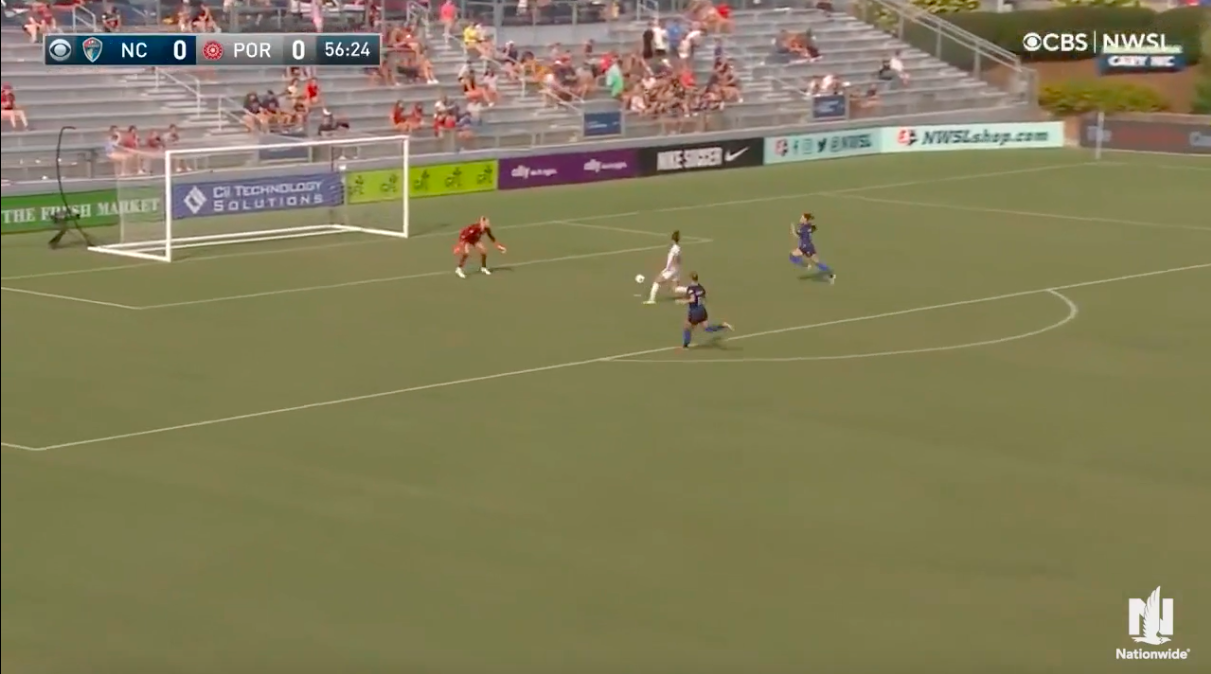
In this still, right before Smith struck the ball, Smith’s body is facing toward the left hand side of the goal. However, she doesn’t go there. Reading the keeper well, Smith strikes the ball with the outside of her right foot, sending it to the near post and catching Murphy off-balance.
Smith leads the entire league in shots, and while she isn’t consistent yet on her conversion rates, her ability to read the game and control her body allows her to score at crucial moments. Goals like the one in Sunday’s game are not an accident or a statistic probability; they are well-intentioned. As Smith continues to grow into the league, she will become even more lethal.
Also of note, it was good to see Tyler Lussi back on the field after so long out! Hopefully Simone Charley can come back soon because the Thorns’s front line will truly be frightening with all forwards fit.
Portland now heads off on international break, with the six players called up by their national teams joined by Mark Parsons as he officially begins coaching the Dutch National Team.

The Thorns fell 1–2 to their rivals from the north on Sunday. It was an exciting game that may be remembered as the moment the Reign completed their transformation into the superteam they’ve looked like on paper since the arrivals of Dzsenifer Maroszán, Rose Lavelle, and Eugenie Le Sommer.
Back under our old friend Laura Harvey and playing for the first time ever at the Seahawks’s Lumen Field, the Reign employed a clever game plan that both maximized their strengths and capitalized on the weaknesses in Portland’s setup.
Let’s take a look at the Reign’s first goal, which exemplifies both sides of that equation. In the screenshot below, Portland has just won possession off a Reign goal kick, and Maroszán is chasing Lindsey Horan, limiting her passing options:
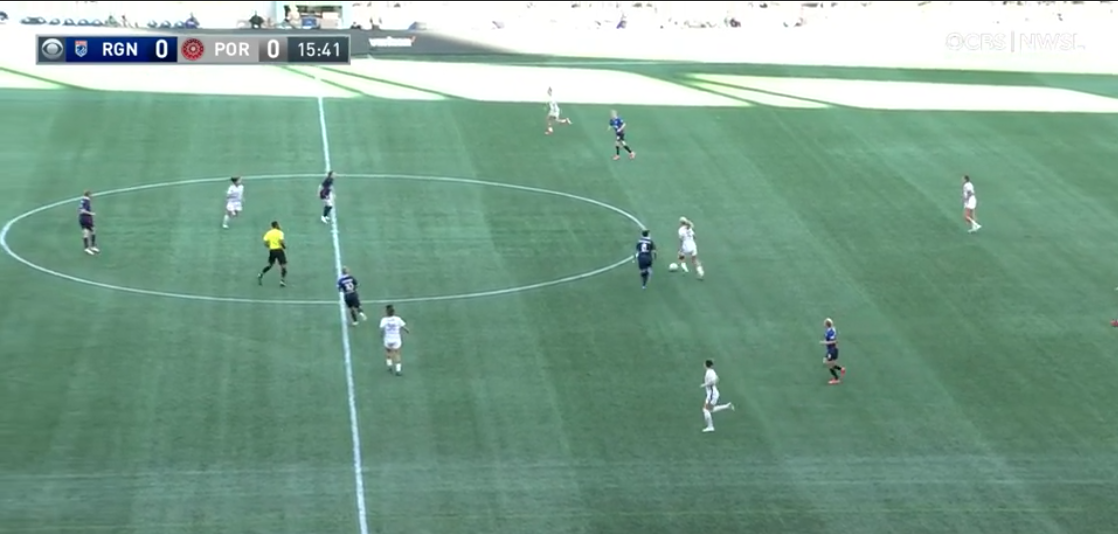
Horan’s options on the left side of the field are cut off; most players would also see the passing lane to Rocky Rodríguez, in the center circle, as being blocked by Rose Lavelle, leaving Christen Westphal on the right as the only option. She’s wide open, too! But whether it’s because Horan isn’t at 100% mentally—she hasn’t looked like she’s quite clicked back into place with the team in the last couple games—or because she’s Lindsey Horan and has completed this pass plenty of times, she opts for Rodríguez. Lavelle scoops up the pass, Maroszán and Jess Fishlock close in, and Fishlock finds Megan Rapinoe sprinting up the Reign’s left wing:
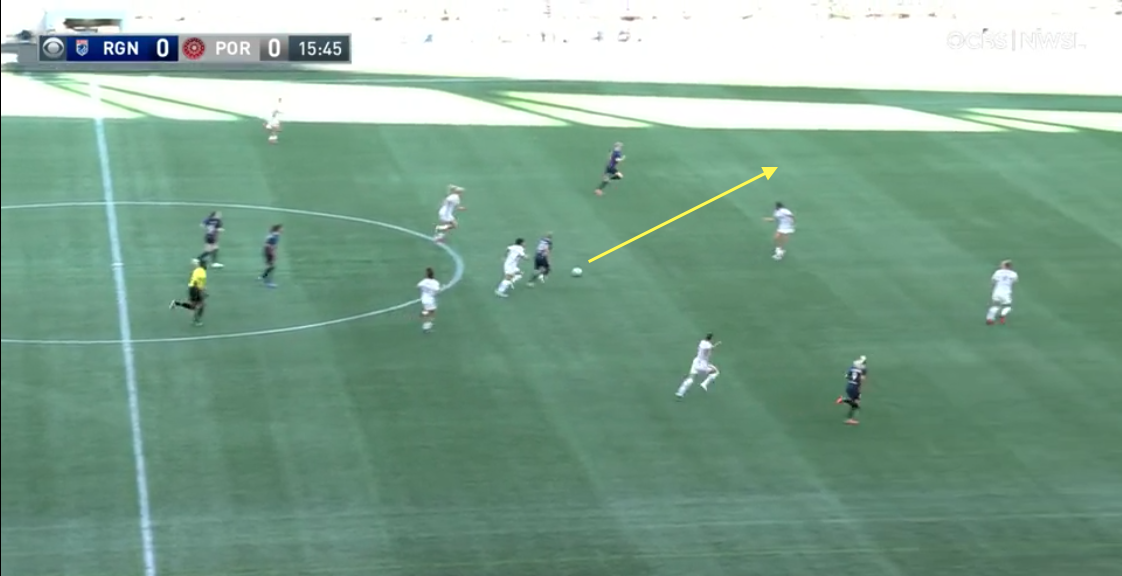
Clearly, the Thorns are in big trouble now. Westphal and Natalia Kuikka were both pushing forward, leaving tons of space behind them. At this moment, Kuikka is dropping back but has to keep her eye on Le Sommer on the right, while Westphal is miles behind Pinoe, so Emily Menges and Becky Sauerbrunn are left in the lurch. Menges is left guarding Pinoe one on one, and that’s the ballgame.
Portland’s defense found themselves resorting to heroics a number of times in the game, as the Reign took advantage of that wide space. They also cleverly deployed Maroszán in a false No. 9 role, using her to press the Thorns’ deeper-lying players on defense and then combine with the midfield once her team won the ball. She was effective both with her pressing, as we saw above, and as a creator, notching two chances created on the stat sheet.
Defensively, Tacoma aimed to make the center of the field as claustrophobic as possible for Portland’s dangerous midfield. They used a low line of engagement, generally not pressing above the halfway line, but pestered the Thorns midfield aggressively in their own half. Here it also has to be said that the current Reign midfield of Fishlock, Lavelle, and Quinn—plus Maroszán, in practice—rivals the Thorns’ for the best in the league. Fishlock, obviously, eats nails for breakfast, Quinn is a gold medal-winning No. 6, and Lavelle is demonstrating she can be a destroyer in addition to an offensive wizard. In short: a formidable trio!
OL also tended to stay compact horizontally, the better to crowd the central midfield. In doing that, they often ignored the Thorns’ outside backs as they pushed forward in the attack. That left Kuikka and Westphal (and anyone else who found themselves wide of the goal area) open to send in crosses, but with the Reign defense packed in tight as Portland tended to be slow to find those options, only one cross out of 18 total found its mark.
This is where things get a little more nuanced. No doubt this was one of Portland’s poorer performances this year, but I also think it was a closer match than a 2–1 scoreline would imply. The defensive strategy I just outlined, like all defensive strategies, had some vulnerabilities. In particular, pressing always opens up space somewhere on the field, and in Tacoma’s case, that space was between their midfield and back line, which is quite a dangerous area of the field to leave space in!
Below, Angela Salem has just won the ball off of Kristen McNabb (I think) and tapped it to the white area that I think is Rodríguez, who is about to find Crystal Dunn in a big comfortable pocket ahead of the Reign defense:
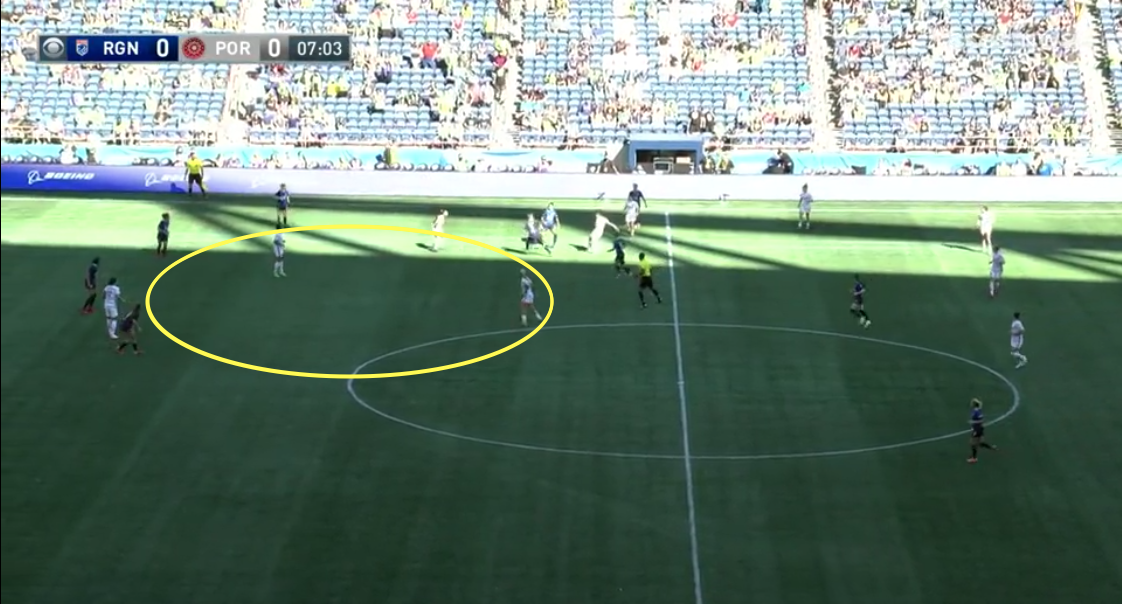 After this, Fishlock and Quinn kept following the ball as the Thorns passed it around, Sophia Smith and Christine Sinclair stretched the OL back line, and Smith ended up with a clear shot at the goal—which she sent straight to Sarah Bouhaddi.
After this, Fishlock and Quinn kept following the ball as the Thorns passed it around, Sophia Smith and Christine Sinclair stretched the OL back line, and Smith ended up with a clear shot at the goal—which she sent straight to Sarah Bouhaddi.
Smith had a handful of similar chances where the Reign midfield’s aggressive orientation toward the ball came back to bite them, ending the game with a team-leading six shots. In other words, the space was there, the Thorns were just too slow and inconsistent in recognizing and capitalizing on it.
That particular chance was a microcosm of Portland’s issues as a whole. A number of players, including Rodríguez and Menges, looked gassed from the starting whistle. This team has had an exhausting schedule in August, playing five games in 16 days. Smith in particular, though, seemed to exemplify what Mark Parsons identified postgame as the real fallout of that schedule.
“Physically I thought, some of the players today, they still looked like they could go,” he said. “But mentally, definitely. Mentally and emotionally, there was a little more in the tank for them, a little less in the tank for us.”
We’ve seen Smith struggle with finishing this season, but from the press box at least, this looked like a slightly different issue. Where in the past, she’s sometimes seemed to be overthinking where to place the ball once she gets in on goal, on Sunday she tended to find those chances and just… kick.
This isn’t to single Smith out—the team was a beat slow across the board, and understandably so. The full week of rest and training ahead is sorely needed, and hopefully the Thorns emerge looking more like themselves.
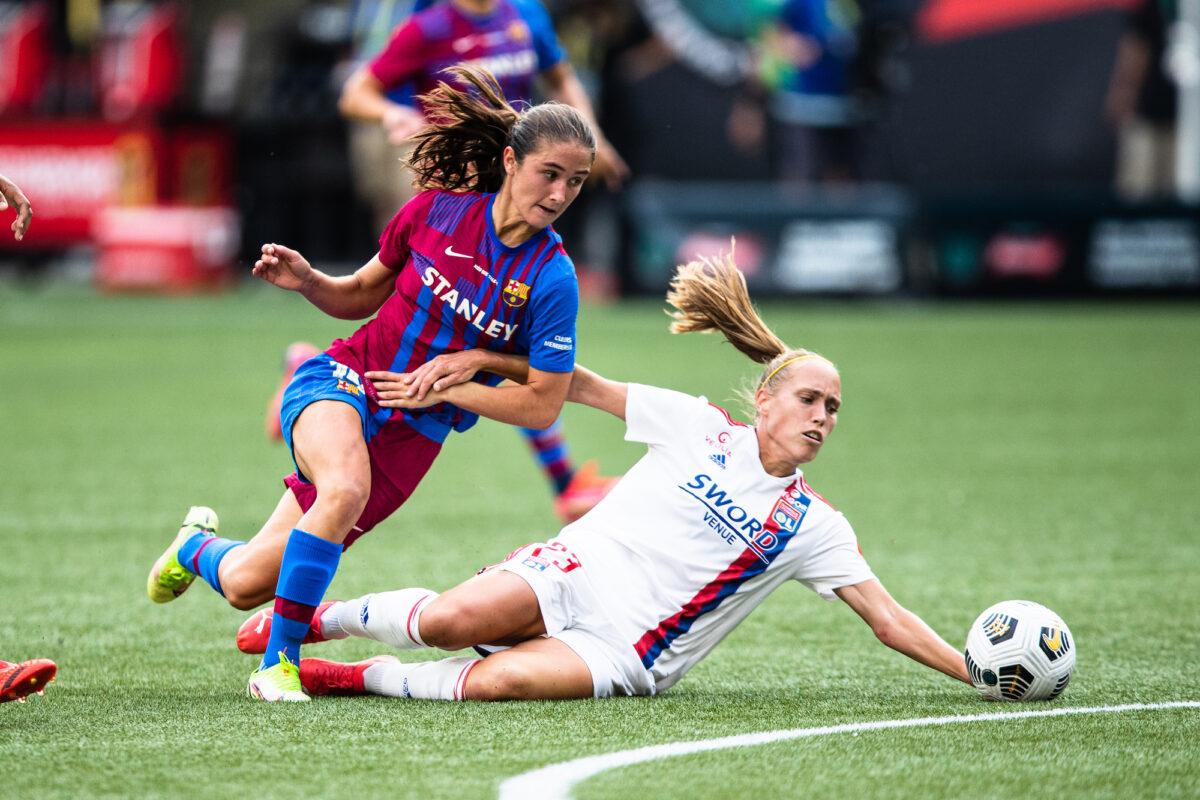
In the opening games of the WICC at Providence Park yesterday, Lyon played beat Barcelona 3–2 in an exciting, high-quality match. Later in the evening, the Portland Thorns played the Houston Dash to a 2-2 tie. The match went to penalties, and the Thorns came out on top, beating Houston 3–1 in the shootout.
But I come to you bringing observations of the 90+ minutes of each game, whether you were cheering for Lyonnais, Barcelona, the Thorns, or the Dash.
FC Barcelona vs Olympique Lyonnais
1. Olympique Lyonnais made the most of their back line while countering. With Barça disorganized defensively after attacking, and some of their players spread out to follow their marks, OL opened up to find space immediately, and their back line sent passes up wide or through the middle. This tactic was used in one of Lyon’s attempts on goal late in the first half, which nearly succeeded. Barça’s defense was often unprepared and didn’t anticipate the sudden switch of speed.
2. Barça used their midfield and attacking third to send crosses through Lyon’s defensive line whenever they were caught flat, which happened often during the first half. Lyon was slow to counter at times, allowing Barça to move in for crosses and runs. Because Lyon’s defensive line was often so flat, they were caught having to rush back on defense to adjust for an incoming shot or pass.
3. The two teams’ ball movement differed visibly. Lyon used fluid movement switching from one side to the other and using passes and runs up the sidelines, while Barça attacked more centrally, sending passes straight through the middle, as well as using many more crosses. That difference was pivotal to the result of the game. Lyon’s passes and runs from wide areas helped spread out Barça’s defense and created gaps to allow Lyon players through their lines. On the other end, Barça’s crosses helped them move the ball efficiently when Lyon’s own defense was slow to recover and drop back.
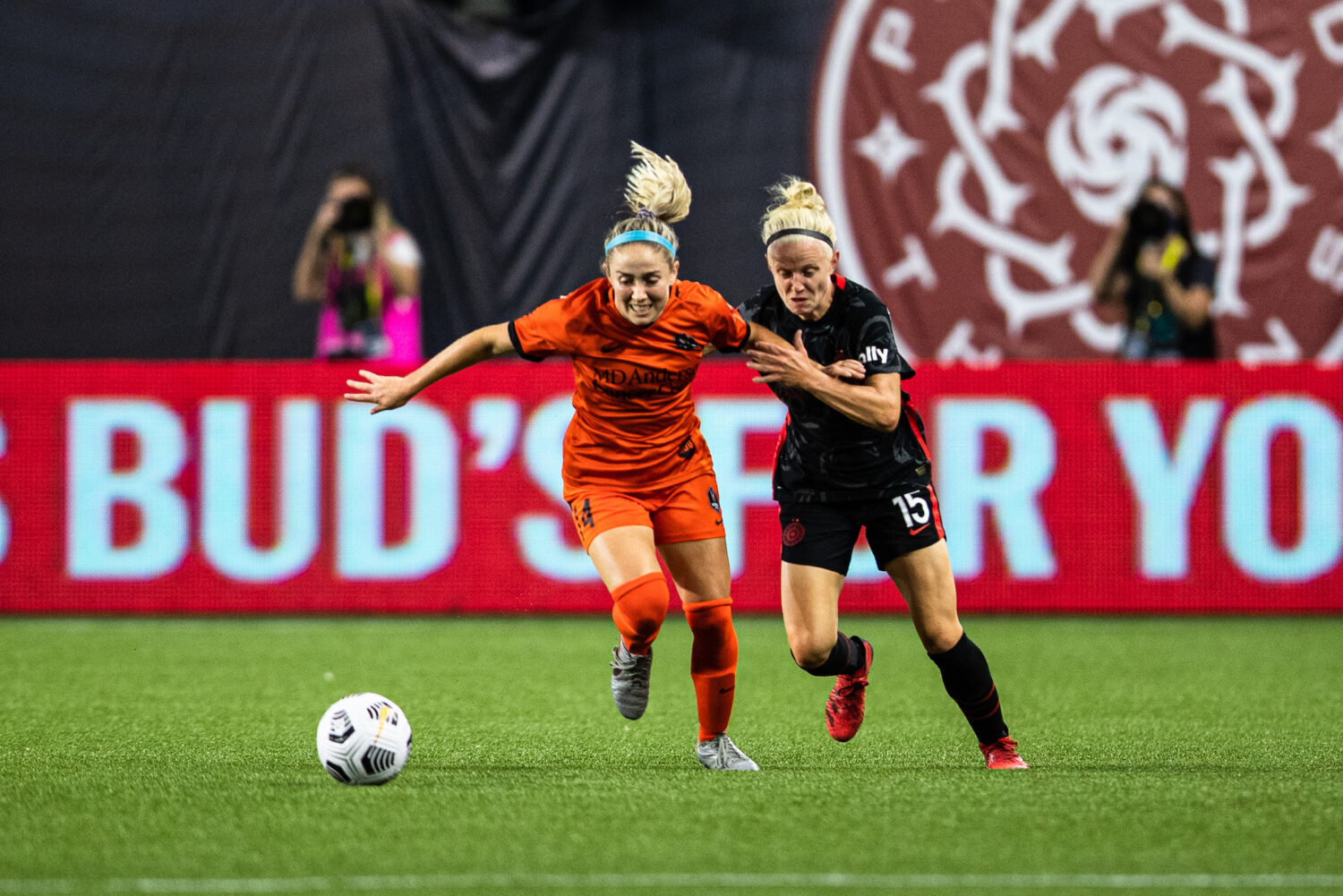
1. Early on, Portland’s starters struggled with their movement around the field, but gradually settled in as the game continued. The beginning of the match was a little messy, and it took me longer than usual to analyze the teams’ formations and movement, and to gain an understanding of how the two teams were approaching their opponent. As the game progressed, however, the Thorns’ movement improved. Some players started to switch sides to get into more comfortable positions and to confuse any defenders marking them. Forwards Sophia Smith and Taylor Porter, for example, often switched sides. After some of the chaos settled, the Thorns worked their way into the game.
2. The Houston Dash used the width of the field to pressure the Thorns centrally. The Thorns’ 4-1-2-1-2 formation meant they had a lot of players in the central midfield and were able to push several players forward when needed. With the center crowded with Thorns players, Houston had to find an alternative to breaking Portland’s defensive lines. They used the wings on offense, but used their own defensive line to pressure the center of the field and prevent Thorns attackers from getting chances centrally and in Houston’s box.
3. Subs from the Thorns at the beginning of the second half changed things up. With the Dash leading 2–0, a change was needed to at least catch up to the Dash. When Emily Menges, Simone Charley, and Hannah Betfort joined the fray, Charley’s speed meant counter attacks were in order. Bringing the ball forward for attacks more often led to more and more scoring opportunities, including corners—one of which gave the Thorns their first goal.